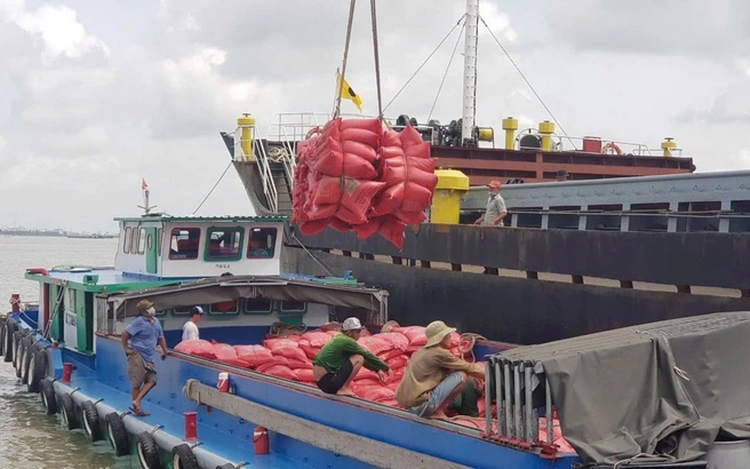
Vietnamese rice is loaded for export at My Thoi Port in An Giang Province, southern Vietnam. Photo: Buu Dau / Tuoi Tre
The Philippine Department of Agriculture recently announced that it may extend the rice import suspension through the end of 2025, beyond the previously stated period of September and October.
This move from Vietnam’s largest rice buyer has prompted local exporters to reconsider their strategies.
Phan Van Co, marketing director of Vietnamese rice exporter Vrice Co. Ltd., said while the Philippines is halting rice imports, Vietnam’s certain commercial contracts, mainly with Indian rice exporters, are still being fulfilled under specific conditions.
Therefore, seeking new markets is a natural and ongoing effort for Vietnamese rice companies.
“Our long-standing approach has been to avoid relying on a single market," Co said.
"Besides the Philippines, we’ve shifted attention to African markets.
"The Philippines accounts for roughly 30–40 percent of Vietnam’s total rice exports."
However, he noted that African markets generally favor Indian rice.
Vietnamese exporters have approached these markets cautiously, partly due to high logistics costs and especially the risks involved in payment.
Currently, Vietnam’s rice exports are mainly aromatic varieties, with limited supply of white rice.
Restrictions on imports of white rice from Cambodia have also led to low domestic stockpiles.
“In fact, major Vietnamese exporters are hesitant to sign new contracts—not because there are no buyers, but because market prices are low, profits are thin, and the situation is changing rapidly. Businesses are waiting for clearer information,” Co explained.
Despite difficulties in its primary export market, Vietnam’s rice sector has seen strong growth in other regions, indicating that diversification efforts are paying off.
According to the Vietnam Food Association, there has been a notable surge in rice exports to Ghana, which has unexpectedly become Vietnam’s largest rice importer, accounting for nearly 22 percent of total exports.
Côte d’Ivoire follows with 21 percent, and Malaysia with 10 percent.
Bangladesh is another rising market, while rice exports to China have rebounded significantly after years of decline, surging more than 141 percent year on year.
Concerns for 2026 rice exports
While the export pressure for the remainder of 2025 remains manageable, Vietnamese businesses are worried about a prolonged global rice surplus and its impact on contracts scheduled for delivery in 2026.
The winter-spring crop, which peaks in March and April, typically sees aromatic rice priced at VND13,000–14,000 (US$0.49-0.53) per kilogram.
However, current prices have dropped to VND10,000–11,000 ($0.37-0.41) per kilogram.
“Companies will look to sell domestically, target new markets, and manage inventory," Co said.
"There are only a few months left in 2025, but we’re already concerned that early 2026 will bring further price pressure, especially during the peak winter-spring harvest."
Vietnam has set a rice export revenue target of $5.7 billion for 2025. This poses a challenge for exporters.
Several companies are now shifting focus to the EU, South Korea, Japan, and Singapore.
A rice exporter based in Ho Chi Minh City said, “We’re exploring additional export markets and diversifying raw material sources to reduce tax pressure and dependence on a single market.
“We’re also evaluating rice-based processed products such as noodles, vermicelli, and rice paper.
“Additionally, we aim to collaborate with other businesses to reduce logistics costs when expanding into promising markets like Ghana, Côte d’Ivoire, and the UAE with both aromatic and white rice varieties.”
According to the Vietnam Food Association, rice exporters are facing dual challenges: the impact of the Philippines' import ban and complications with VAT refund policies following new regulations that took effect on July 1.
A representative of the association said the domestic rice market in the Mekong Delta has stagnated, with traders reducing purchases due to concerns over limited export opportunities.
If this situation continues until the end of the year, exporters will face losses, and farmers’ incomes will suffer due to falling paddy prices.
The association has submitted a proposal to the Ministry of Industry and Trade, requesting that it send an official letter to the Philippine Department of Agriculture to help address difficulties and ensure Vietnamese businesses can continue exporting.
Alternatively, the association asked for clear guidance on which rice varieties are covered under the temporary suspension, the representative said.
This request is based on the memorandum of understanding on rice trade cooperation signed between the two countries on January 30, 2024, which remains valid until December 31, 2028.


Max: 1500 characters
There are no comments yet. Be the first to comment.